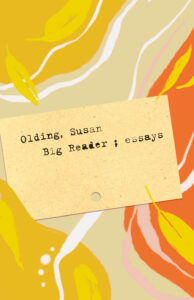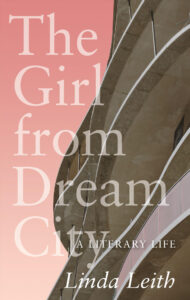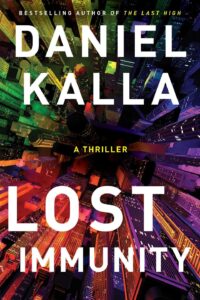May 13, 2021
The Adventures of Miss Barbara Pym, by Paula Byrne

I…don’t like big books. They’re heavy to hold, don’t fit in my purse, and I’ve just got no time for that, for the most part. It just doesn’t groove with the pace of my life, and so at 612 pages, I was intimidated by The Adventures of Miss Barbara Pym, Paula Byrne’s biography of novelist, the first since a 1990 biography by Pym’s friend and literary executor Hazel Holt which might have revealed fewer insights that it could have out of respect for Pym herself, who’d died of cancer in 1980.
But reader, I read it in two days. Granted, these were two days I’d set aside especially for it, turning off my wifi and accompanying social media so all my attention could be focussed on the task at hand, which was giving my poor wrists the support they needed to hold Byrne’s biography up to my eyes. But it helped that Byrne had divided her book into short and action-packed chapters in the style of 18th century novels like Moll Flanders, chapters with titles such as “In which our Heroine is born in Oswestry,” “In which Miss Pym returns to Oxford,” and so on to “In which our Heroine goes to Germany for the third time and sleeps with her Nazi.”
TURN BACK, BARBARA! was what the residents of my household took to shouting as I kept them abreast of developments in the narrative, such as when Barbara was having an affair with her friend’s father, various gay men, her roommate’s estranged husband, and yes, a literal Nazi. Barbara Pym was an extraordinary person, a brilliant novelist, and had comically terrible judgment when it came to men (and 1930s’ political regimes). Although it occurs to me that her terrible judgment may have been what made her such a wonderful novelist, her ability to imagine her characters into the impossible situations she’d often encountered herself. She took the tragedies (and absurdities) of her own life and spun them into literary (and comic) gold.
Barbara Pym was a fascinating woman—a student at Oxford in the 1930s, she was an enthusiastic participant in sexual relationships, and imagined herself into all kinds of romantic dramas, her particular obsession with one lover occupying her for the rest of her life. She was very drawn to Germany in the 1930s, displaying that typical judgment I’ve always mentioned, but this did not persist into wartime, where she would serve with the WRENs in Naples. After the war, she was hired as an editor for an academic journal in anthropology, which served as fodder for her work (oh my gosh, her treatment of office dynamics and whose job it is to put the kettle on and how is SO SPOT ON) but also paid her a pittance. Being a novelist was most fundamental to her identity out of everything else she did—her first novel, Some Tame Gazelle, was published in 1950. She’d been working on the novel since her Oxford days.
Throughout the 1950s, she published five books, her sixth appearing in 1961. And after this, her new work was not accepted by her publisher, nor by any another. The fashions were changing, and so was the publishing industry (everyone thought the industry was just as dire then as they have ever since), and Pym’s understated humour and wry old-fashioned sensibility had not kept up to date, it was said. So she would toil in the wilderness, encouraged by her excellent friend Philip Larkin, and these years were hard ones for her—money was a struggle, she was depressed by romantic relationships that didn’t pan out, she encountered health struggles, and felt left behind by the literary scene.
And then everything turned around—in 1977, Pym was mentioned (twice!) in a Times Literary Supplement list of underrated writers. All of a sudden, the newspapers and radio were calling. Her publisher wanted to put her back into print, she relished in rejecting them this time, new works coming out with MacMillan, her earlier books re-released. Her next novel, Quartet in Autumn, was nominated for the Booker Prize. Pym would be celebrated before her death at the age of 66, which gives this life the happy ending her biography’s reader longs for. The kind of triumph that doesn’t always happen in life itself, and seems more fitting for a novel instead (but then we’d call the conclusion a little bit pat).
Byrne refreshes one’s perception of Pym in this biography, whose title and form is entirely suited to a life that wasn’t quiet at all, and which pushed the margins in all kinds of ways. She also shows the way that Pym’s work was a reflection of its times, and changed along with the fashions, responding to the world around her, even though many of her preoccupations (spinsters and curates especially) remained the same.
May 11, 2021
Gleanings

- The restorative qualities of being in nature, or “green space,” are well documented, but researchers have only recently begun to focus on what changes when water is part of the picture…
- …you don’t have to agree with everything he says but the point is to go on thinking about things, perceiving things, however desperately, to go on looking deeper at the world and how it works
- I’ve been making focaccia a lot this year…
- We have a new table in our kitchen. It’s not really a table and it’s decidedly not new, but it’s a surface we’ve recently unearthed and put back to use.
- For nearly 40 years I’ve come up our driveway to see the wisteria blooming in May and each time I’ve felt overcome with its beauty.
- Finally, there is also nothing like being welcomed to a team where you know absolutely no one, and the next thing you know, you’re bonding over books and authors and food and beer and music, and then just like that, you’ve made some lifelong friends.
- And as I have written before, understanding is not an agreement, or forgiveness or an apology.
- Here then, a celebratory list of the newsletters I’m glad to sit down with…
- I miss exposition, linearity, confidence that the novel as a form is robust enough to be “traditional” in these ways and still new.
- She worked and taught and dreamed mathematical dreams, and I am grateful to have seen that, every day, at home. Even though she yelled at me often about the inadequate sharpness of my pencils, I know she did it from love. As mothers do.
- There’s a kind of magic that happens in the gloaming; a glorious solasta before the sun dips below the horizon.
- The rhubarb was so tantalizing, I selected a few stocks to bring home for pie or a cake. Once home, not feeling like making pie crust, I thought of my mom and her favourite rhubarb cake.
- Barometric pressure affects me but there isn’t much I can do to control that…
- Cinnamon buns are perfect — they don’t need disruption, nobody needs a fresh new take on them, and they don’t need refining.
- I emptied my wallet today for the first time in well over a year and I felt like I was sifting through another woman’s things
My next blogging course starts on June 1 and it’s LET’S GET TOGETHER, a low stakes, low cost, HIGH FUN community experience. Hope you will join us!
May 10, 2021
Big Reader, by Susan Olding
Susan Olding’s essay collection, Big Reader, is a bibliophile’s delight. The follow-up to her 2008 collection Pathologies affirms should be on the radar of all book-loving people whose hearts skip a beat at the sight of Natalie Olsen’s marbled cover art, a riff on vintage endpapers. But then of course if you look closely, you will notice that the design is less abstract than it first appears, and the marble is a river, and leaves are floating on its surface, and a leaf can be the page of a book or something growing on a tree, to be gathered with a rake when it eventually flutters to the ground, and there’s even an essay on rakes, as in the garden tool and the 18-century series of engravings by William Hogarth “A Rake’s Progress.” Mutability is a theme of, well, life itself, as Olding’s collection attests.
She writes about Anna Karenina and her own affair in a fabulous essay on rereading. She reflects on infertility at Keats’ house. (I just finished reading Barbara Pym’s new biography, which also includes a scene at Keats’ house, a tragic scene in which Pym occurs in a cameo role in one of her novels. It seems like no one has a lot of fun at Keats’ house.) Fairy tail tropes and stepmothering in her essay “Wicked,” which first appeared in the essay collection The M Word, which I edited in 2014. Inspired by Woolf, she writes of “Library Haunting.” On how her mother’s reading life changed as the result of her vision loss. About reading The Golden Notebook on a resort vacation to Hawaii, kind of incongruous. In “Another Writers Beginnings,” which is a response to Eudora Welty and seems in conversation (or at least keeping rhythm) with Joan Didion circa Slouching Toward Babylon, Olding writes a take on self-doubt that I found against the grain of our current moment and also absolutely refreshing—that our self-doubt can serve us as writers. Who would we be without it?
I’d read in a previous review that Oldings essays on Toronto during the AIDs crisis (and the Don River) and another on blood types seem incongruous with the collection’s theme of books and reading, but they actually worked for me, for the way that Olding reads the landscape like a story in the former, and the body in the latter, always searching for signs. She writes about working at a bookstore in downtown Toronto, and how she used to read at the counter, and the oversized atlas kept getting stolen on her watch. Throughout the whole book, she writes about a refusal to conform, to fall into line, to veer into the unexpected, to be one thing and then quite another. “I needed to wander. I wanted to follow a string of words.”
May 7, 2021
Speak, Silence, by Kim Echlin
It’s a difficult sell, Kim Echlin’s novel Speak, Silence, about the International Criminal Court Trials after the Yugoslavian wars that for the first time prosecuted rape during wartime as a crime against humanity. I will admit that I might not have picked it up were I not given the opportunity to interview Echlin for a live book event this week, but am I ever glad I did. The rare kind of novel that has been engaged the way of nonfiction, pausing in my reading to leap down internet rabbit holes and learn about parts of history of which I’d had absolutely no idea (the history of how Bosnians became predominantly Muslim—it’s fascinating!) and I kept turning to my husband and asking myself, “Did you know….?”
Unfortunately the question usually ended with a detail like, “that women were kept imprisoned, raped and tortured, and intentionally made pregnant with genocide as the desired outcome?” Most of that is not explicitly in the book, but instead what I came to understand as I perused internet articles on what happened in Foca, and Bosnia, and all these things that were going on in the backdrop to my life in the 1990s, subjects of television reports. The kind of thing that happens “over there.” How did I never know about this? And Echlin’s novel is both an echo and an answer to that question.
Speak, Silence is a fascinating companion read to Miriam Toews’ Women Talking, a book about violence against women in which the violence is not gratuitous and indeed far from the point, which instead is agency and storytelling, and the power of listening and also being heard. There is a strange tension through Echlin’s text that is suggested by its title, a sense of both-ness. An irreconcilability. That nothing can change or fix what was done to these women and the pain and suffering they live with, and that a criminal trial is still an inadequate way to address their experiences, and yet it’s also everything. That testifying can reopen a woman to pain of her experience, but also permits her a kind of power. That these women who are brave enough to tell their stories, overcoming shame and stigma in order to do so, are finally permitted the power of shape the narrative of women and war, one that has centered on men since the time of The Iliad. Echlin writes about the granite memorials to war dead in the former Yugoslavia, and really everywhere. But nowhere do we find memorials to what happened to these women, and so many women before them.
But the trial itself is a memorial, and Speak, Silence builds upon the trial to further bring these women’s experiences and stories into the consciousness of readers. Echlin choosing to fictionalize the stories, she told me on Tuesday, because it’s through fiction that readers truly get to inhabit another’s experience. And yet there are limits to this too, of course—more of the both-ness I mentioned. The novel is a testament both to empathy and also to its limits. Echlin’s protagonist says, “I did not want to use the word trauma because we all think we know what trauma means but I do not think we do.”
That protagonist, Gota, is a Canadian journalist who has spend the 1990s in Toronto with her small child, the result of a love affair she’d had in Paris with a man from Sarajevo. Uncomfortable with being a mere onlooker via the TV news, Gota travels to Sarajevo to reconnect with him, and meets Edina, the woman he’s always been in love with who is in love with a different man. Edina, a lawyer, has been collecting the stories of women who’d suffered during the war, understanding how these stories could come together to make a case against the perpetrators. And Gota and Edina become connected, Gota wanting to understand what these women had experienced, taking their stories and holding them. She attends the court trials in the Hague, and Echlin outlines the administrative demands of such a thing, the translation and interpretation required for these women to be understood. Gota is determined to learn these women’s stories and write about them, memorialize them, and her character’s intentions are analogous to Echlin’s as she created the novel.
Gota’s daughter stays with Gota’s mother in Toronto, and the reader learns about Gota’s mother’s own past, one touched by war and tragedy, and this story line is a pairing with that of Edina, her daughter, and her own mother, three generations of women, and inter-generational trauma, and resilience, and the heavy price of silence, even when speaking comes with a cost of its own. It’s a curious shape for a novel, just as the love triangle at its centre is also strange, but this is a novel whose shape is more of a web (a net?) than something more linear. There is no such thing as a peripheral character; there is no such thing as periphery at all. Instead, there is connection after connection, bridges being a central symbol in the story (both literal and figurative). The language in the story is so fascinating, subtle and understated, and yet the words themselves are like traps, double edged and tricky.
It’s not a tough book to read—it’s not even long. It’s brutal in a sense, but just as beautiful, Echlin embodying both-ness again by making death-and-violence and undying love both absolutely true at once. Narratively speaking, it’s really curious but fascinatingly so, layer upon layer of meaning, and it’s impossible not to thoroughly engage with, the reader taking the story within and being changed by it, which is just what its author intended.
May 6, 2021
On Specificity

What I find most fascinating about our pandemic times is the way that Covid-19 resists all generalizations. Are the kids all right or aren’t they? Are your chances of contracting the virus high or low? If you go become infected, will you have a mild case or become deathly ill? Will you recover easily or have persistent symptoms? Are you safer at home than you would be in the world? And one’s point of view certainly depends where it is coming from: an ICU doctor certainly has an important perspective, but such a person also has a highly specific experience of Covid that doesn’t necessarily inform anyone’s experience in general. The same can be said for any middle class white person ensconced in their bubble who doesn’t know a single person who’s been seriously affected by the illness.
A meme from a left-wing meme generator went around this week comparing infection rates in Calgary to those in India, which are apparently lower, and the meme was meant to be sensational, and it wasn’t wrong, but it was also highly irresponsible because with Covid-19, context is everything. And the contexts of Calgary and India are so far apart that comparison is ridiculous, but it’s also hard to get people really hyped up about specification. About a virus that affects so many people so very differently, and of course it’s hard to balance appropriate public health measures to control such a thing, and it’s even harder to really understand how to tell the story of it at all.
That racialized people and those living on lower incomes or in poverty seem to be disproportionately affected is one thing that seems to be true across the board. And after that, I don’t even know. Because there are people over 100 who recovered. There are people who are in their 30s and dying in their sleep. From the first time we encountered the virus, it’s been determined to defy the terms and rules that we set for it. Covid-19 is a non-conformist.
And what do we do with that? How do we tell of a story of something that’s affected each and every one of us on such a high specific level? Or are we kidding ourselves to ever suppose that any story is actually like this? Are there any universal truths? And I wonder if there’s not a lesson inherent in all of this about how complicated and specific most ideas actually are, and their lack of applicability across the board. I am starting to wonder if there is no such thing as a system, and if this chaos, however much we’ve managed to harness it, is the closest we’re ever going to get to order, and maybe instead of resisting, we should lean into it, which would be to see things as they are.
Specificity, right down to the atom. This is like how World War One broke everybody’s brain. I think I may be finally coming to modernism, and I’m only one hundred years late.
May 4, 2021
Gleanings
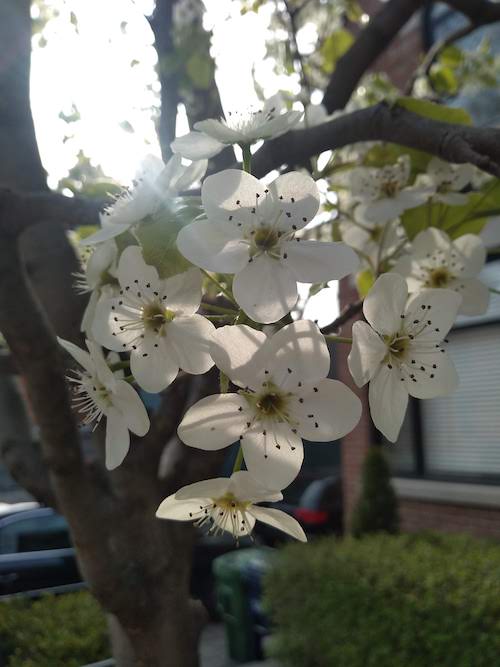
- If you observe and you plan, in other words, if you adjust and you trust what the data shows, you can send a rocket ship to Mars.
- Seven Things You Don’t Need to be an Artist
- My kitchen table holds a small bouquet of flowers that have brightened each of my days in the past week.
- I probably shouldn’t complain when Mother Nature is showing off so beautifully but oh, what a labyrinthine year it’s been…
- It breaks my heart when people refer to him in the past, though I understand why they do. He is not the person we used to know. And past imperfect is the correct choice, alas, for many of his loves and hobbies…
- A moment in which most things feel possible; the moment in which I haven’t yet dropped anything irrevocably today and I can maybe pick up some of yesterday’s things.
- Delight is not a respite from our troubled world but a direct and more mysterious engagement with it.
- I think that is what I like so much about soup. It is, by its very nature, a dish that you don’t have to apologize to.
- In 1990, I arrived at the Fine Arts Work Center in Provincetown, Massachusetts, having no idea that the greatest gift of that seven-month fellowship would be the start of a lifelong friendship with Elizabeth McCracken.
- I have been thinking about Carl Sagan and his passion for science.
- I’m remembering how we learn to be parents—and thinking about what it means to offer love and support, when someone’s parenthood is new.
- Instead, she owns these actions and their role in her life. Many of them were physically harmful, all of them were attempts to lessen spiritual pain. And all are part of her, part of what she has fused to create herself—a complicated woman and skilled writer.
- What a wonderful thing to be at a point in your life when you can do something like this, unapologetically, and so beautifully.
- But we have no choice but to begin again. To roll out a fresh slab. Smooth out the bubbles. Wrap it well. Be patient. Cross our fingers. And our toes.
- So there you have it. The Curious Case of Janet Dailey and the Missing Author.

My next blogging course is coming in June. It’s called LET’S GET TOGETHER, and it’s a low cost, low stakes, high fun opportunity to dip your toes in the blogging water. I hope you’ll join us! Register today!
May 3, 2021
The Girl from Dream City, by Linda Leith
I have become unfathomably bored with the self-mythologization of male writers in my middle years, with all their memoirs and collected works, and stories about all the pretty young women lining up to fuck them. With the takeaway from their examples—that this what a genius is, what an artist is. That these men are the definition of the literary life. Their pompousness, and entitlement to take take up space—but of course, these men are usually compensating for something. If any of them had truly attained the status they believe they are due, wouldn’t they have other people to do the mythologizing for them?
And then along comes Linda Leith’s memoir The Girl From Dream City like the tall glass of water I didn’t even realize I was thirsty for. I loved this book. A book that Leith claims in the end is not a memoir, but more of an essay: “an attempt at approximating what really happened. A prose work, certainly. It has an uncertain basis in what really happened to someone who resembles this girl, the adolescent, the young woman, the older woman—all the characters I might have been, once upon a time.”
In The Girl From Dream City (the title taken from a remark by Pauline Kael about Carey Grant, referenced in Zadie Smith’s essay “Speaking in Tongues”), Leith writes about her extraordinarily peripatetic childhood—born in Northern Ireland, and then to London where her parents are ardent Communists until Leith’s father Desmond, a doctor, travels to Romania and becomes disillusioned with the realities of the movement, then they’re off to Switzerland, and then Montreal, and then Nairobi—but by that time, Leith is making her own way, studying in London, and then returning to Montreal where her literary life is rooted as she becomes a critic, literary magazine editor, novelist, and then founder of the Blue Metropolis Literary Festival, before creating her eponymous publishing company, continuing her celebration of translation, international writers, and really great books.
I love the audacity of a woman naming her company after herself, and that same audacity is so admirably present in Leith’s memoir, of claiming her triumphs and achievements, though this is a kind of audacity that was a long time coming, as she shows in the book. For while she grew up within a culture of storytelling, Leith herself was not encouraged in this respect, expected to submit to her father’s dominant narrative instead instead, and what he expected of his daughter (which was certainly not independence or any kind of challenge). “Whatever you say, say nothing,” from Seamus Heaney, is the epigraph to her first chapter, and this was also her parents approach to their own stories (particularly those of her father’s mental illness and exile from Communism). A lot of this beautiful book is Leith finally fitting together the pieces of the universe that took a long time to make sense to her.
I also love this book for showing that a vibrant domestic life is not necessarily opposed to a literary one. Leith marries young and has three sons, and during the years her life is consumed by her family’s needs (as she was also working as a teacher), she longs to write, and is not able to. And yet all this would become part of her process too—it reminds me of what Carol Shields writes in the afterword to Dropped Threads: “Tempus did not fugit. In a long and healthy life, which is what most of us have, there is plenty of time… This was not a mountain we were climbing; it was closer to being a novel with a series of chapters.” And full immersion in the literary world, in such a fabulous fashion, would be the chapter that—for Leith—arrives when her children are older, an excellent and fulfilling period that continues, bringing together the various threads of her life—travel, languages, literature, books.
Leith writes vividly about the longing she had for this kind of life as both a child, and as a young mother, dreaming of writing books and fabulous conversations with literary people. And in her memoir, she writes just as compellingly about how she made it so, and the books and writers her inspired her, about the trials and errors, successes and triumphs of her career. That this is what an artist is. That this is what constitutes a literary life, and it really is still subversive for a woman to stand up and assert such a thing for herself. To so fully own her story, and to dare to write her name on things, and it’s only subversive, of course, because self-mythologization is not something women are encouraged in—even when it’s most deserved.
Because what is self-mythologizing after all except telling the story of how one came to be?
In The Girl From Dream City, Linda Leith shows us the way.
April 30, 2021
The Forest App
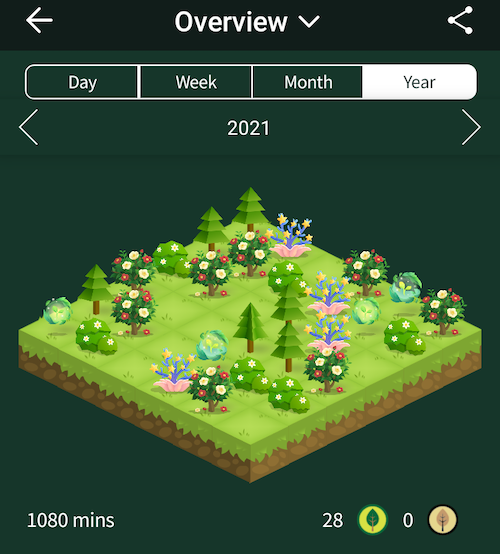
Everybody in my household is obsessed with video games, except for me, who spends weekend mornings reading the paper while everybody else is intent on the Switch, and sometimes I feel a bit left out of the narrative, but mostly I don’t care. I am gad that video games are something my husband gets to share with our children, and I am glad that there’s an adult who’s paying attention to this part of our children’s lives, but video games just don’t factor into my framework at all…except for the one instance in which they really do!
I learned about The Forest App two years ago from an article about reducing cell phone addiction. I’ve used social media blockers on my laptop and phone for years, which is how I manage to write anything that isn’t a pithy instagram story, but the Forest App was kind of a cool twist on the idea of these blockers, generative instead of restrictive. I set a time limit on my phone and if my phone stays undisturbed during that period, I grow a tree in my forest. If I use my phone, the tree dies. And reader: I’ve never ever killed a virtual tree. It would break my heart to kill a virtual tree.
I even have a vague suspicion that I’d have to go out of my way to kill a virtual tree—a couple of times I’ve picked up my phone to check an email and my tree has kept growing anyway, so maybe it’s just the apps or clicking on them. I don’t even know. I don’t want to know. I love that this app that’s only vaguely restrictive and may not even be restrictive at all helps me make good choices for focus even when I could be making different ones. Which is much more meaningful to me than a lock and chains.
A few weeks ago, I finally purchased the pro version of the Forest App, partly because I’m trying to pay for the online things I value, but also because I realized this could make the trees in my forest much more interesting and diverse. Tragically, however, this process deleted the substantial forest I’d been growing over the past year and more, but what can you do…but luckily I was able to start again, and with a camellia tree to boot. As part of their Earth Day challenge, I was able to unlock the luminie plant. This week, I actually increased by focus time from 45 minutes to an hour because I realized I get TWO trees when I do this (and yes, I get extra work done too).
As I grow my forest (while focusing on the work I want to do) I acquire points. I can use these points to unlock more trees, which is how I recently got the camellia. I need 2000 points to plant a plum blossom tree or a weeping willow. And I’ve got my eye on the apple tree and the maple tree (with orange leaves, and a park bench underneath!), and as my forest grows, I’m ridiculously proud of it, beyond my pride at what it represents in terms of attention and commitment to my writing…and everyone I live with is very kind and encouraging and pretends to be interested in my virtual trees.
And of course they are! Because this is my video game! Like Animal Crossing for boring people (or so I assume—I am too boring to know). And what with my virtual landscape and acquired points, what is this whole business but a video game after all. But one that is not remotely a waste of my time. Instead, it’s one that makes the best of it.
Even better? I’m not going to be unlocking any new virtual trees anytime soon, and do you want to know why? Because I’m saving my points. I’m currently at 393 after that camellia tree cleared me out but if I focus hard and work intently, I can earn 2500, at which I can use the points to plant a real tree! The Forest App is involved in the Trees for the Future program in Sub Saharan Africa. I can’t think of better motivation to get down to work.
April 29, 2021
Lost Immunity, by Daniel Kalla
No one really needs to be reading about disease outbreaks during Year 2 of a Global Pandemic, you might argue, but I think you’d be wrong, because Daniel Kalla’s thriller Lost Immunity is about a different disease (meningitis) and because it honestly warmed my heart to come across the book’s references to Covid-19 in the past tense. And because while the book is a compelling plot-driven ride, the ideas it engages with are also timely and vital, and informed by Kalla’s own experiences as an emergency physician in Vancouver BC.
Kalla’s last book, The Last High, about the opioid crisis, was one of my favourite reads of last summer, and the follow-up is even better, mostly because it deals in ideas I’m constantly grappling with anyway these days, about risk and trust, vaccines, and disinformation, and how public health officials are meant to manage anything through all that noise. It’s really wonderful to see these ideas in action, to see them complicated and interrogated in a story about their real world stakes.
The centre of the novel is Lisa Dyer, head of Public Health in Seattle when a meningitis outbreak at a bible camp begins to spread through the community, killing children and teens. Turns out a pharmaceutical company has a new vaccine that’s been through trials and might be the only weapon to stop more people from dying—but she’ll get pushback from the “vaccine-hesitant” community, never mind the fact that both she and the drug company will both have to put their reputations on the line.
But of course because this is a thriller, there is a further complication—someone is trying to sabotage the vaccination program. This aspect of the story heightens the stakes, and underlines the importance of trust and safety, while not undermining the science of vaccination, of which Kalla is well aware. But he also manages sympathetic representation of different points of view—Lisa’s family is opposed to vaccination, and another character is a public anti-vaxxer who blames vaccinations for his son’s autism. Kalla shows that even when the science is sound, the situation on the ground can be complicated, and assessing notions of risk is different in practice than theory, and especially when it’s personal.
I loved this book. A gripping read, but it made me think, which is a perfect combination.
April 28, 2021
New Literary Quiz!
[interact id=”60832d572a5b4e0017c5017b” type=”quiz” mobile=”false”]

